Carrier 58MCB User Manual
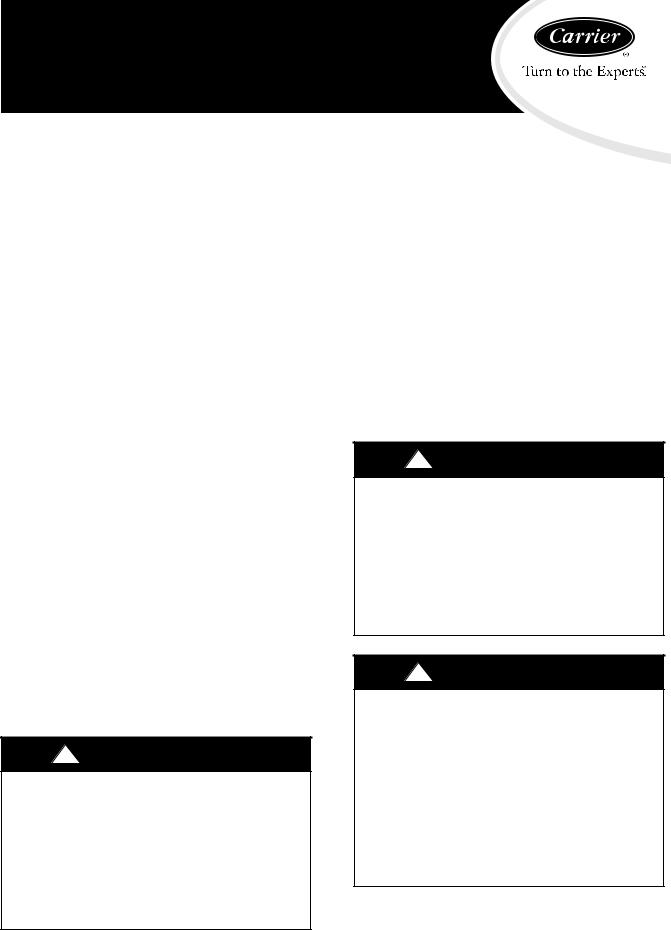
58MCB
4---Way Multipoise Fixed---Capacity Condensing Gas Furnace
Service and Maintenance Instructions
For Sizes 040-- 120, Series 110 & 120
NOTE: Read the entire instruction manual before starting the installation.
TABLE OF CONTENTS
PAGE SAFETY CONSIDERATIONS . . . . . . . . . . . . . . . . . . . . . . . . . 1 GENERAL . . . . . . . . . . . . . . . . . . . . . . . . . . . . . . . . . . . . . . . . . 2 ELECTROSTATIC DISCHARGE (ESD) PRECAUTIONS . . . 2 CARE AND MAINTENANCE . . . . . . . . . . . . . . . . . . . . . . . . . 3
Cleaning and/or Replacing Air Filter . . . . . . . . . . . . . . . . . . . . 3 Blower Motor and Wheel Maintenance . . . . . . . . . . . . . . . . . . 4 Cleaning Burners . . . . . . . . . . . . . . . . . . . . . . . . . . . . . . . . . . . 6 Cleaning Heat Exchangers . . . . . . . . . . . . . . . . . . . . . . . . . . . . 7 Primary Heat Exchangers . . . . . . . . . . . . . . . . . . . . . . . . . . . . 6 Secondary Heat Exchangers . . . . . . . . . . . . . . . . . . . . . . . . . . 7 Flushing Collector Box and Drainage System . . . . . . . . . . . . . 8 Servicing Hot Surface Igniter . . . . . . . . . . . . . . . . . . . . . . . . . 10 Electrical Controls and Wiring . . . . . . . . . . . . . . . . . . . . . . . . 11 Checking Heat Tape Operation (If Applicable) . . . . . . . . . . . 11 Winterizing . . . . . . . . . . . . . . . . . . . . . . . . . . . . . . . . . . . . . . 13
WIRING DIAGRAM . . . . . . . . . . . . . . . . . . . . . . . . . . . . . . . . 13 TROUBLESHOOTING . . . . . . . . . . . . . . . . . . . . . . . . . . . . . . 13 Status Codes . . . . . . . . . . . . . . . . . . . . . . . . . . . . . . . . . . . . . 13 Component Tests . . . . . . . . . . . . . . . . . . . . . . . . . . . . . . . . . . 14
!WARNING
ELECTRICAL SHOCK, FIRE, OR EXPLOSION HAZARD
Failure to follow safety warnings exactly could result in dangerous operation, personal injury, death, or property damage.
-Before servicing, disconnect all electrical power to furnace. -When servicing controls, label all wires prior to
disconnecting. Reconnect wires correctly.
-Verify proper operation after servicing.
SAFETY CONSIDERATIONS
Recognize safety information. This is the safety-alert symbol  . When you see this symbol on the furnace and in instructions or manuals, be alert to the potential for personal injury.
. When you see this symbol on the furnace and in instructions or manuals, be alert to the potential for personal injury.
Understand the signal words DANGER, WARNING, and CAUTION. These words are used with the safety-alert symbol. DANGER identifies the most serious hazards which will result in severe personal injury or death. WARNING signifies a hazard which could result in personal injury or death. CAUTION is used to identify unsafe practices which may result in minor personal injury or product and property damage. NOTE is used to highlight suggestions which will result in enhanced installation, reliability, or operation.
!WARNING
ELECTRICAL SHOCK, FIRE, OR EXPLOSION HAZARD
Failure to follow this warning could result in possible damage to this equipment, personal injury, or death.
The ability to properly perform maintenance on this equipment requires certain expertise, mechanical skills, tools, and equipment. If you do not possess these, do not attempt to perform any maintenance on this equipment other than those procedures recommended in the User’s Manual.
!WARNING
FIRE OR EXPLOSION HAZARD
Failure to follow this warning could property damage, personal injury, or death.
Never store anything on, near, or in contact with the furnace, such as:
1.Spray or aerosol cans, rags, brooms, dust mops, vacuum cleaners, or other cleaning tools.
2.Soap powders, bleaches, waxes or other cleaning compounds, plastic or plastic containers, gasoline, kerosene,
cigarette lighter fluid, dry cleaning fluids, or other volatile fluids.
3. Paint thinners and other painting compounds, paper bags, or other paper products.
1
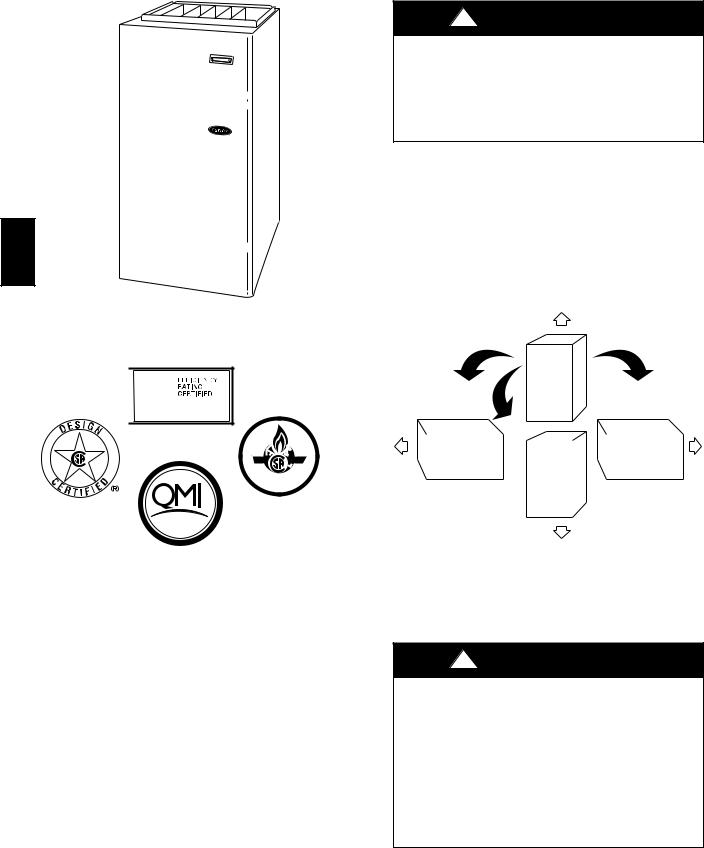
58MCB
A05078
Fig. 1 - Furnace in Upflow Orientation

 ama
ama
ISO 9001:2000
CERTIFIED
REGISTERED
Installing and servicing heating equipment can be hazardous due to gas and electrical components. Only trained and qualified service agency personnel should install, repair, or service heating equipment. Untrained personnel can perform basic maintenance functions described in User’s Information Manual such as cleaning and replacing air filters. All other operations must be performed by trained service personnel. When working on heating equipment, observe precautions in the literature, on tags, and on labels attached to or shipped with the unit and other safety precautions that may apply.
Follow all safety codes including the National Fuel Gas Code (NFGC) NFPA 54-2006/ANSI Z223.1-2006 in the USA, CSA B149.1-05 National Standard of Canada, Natural Gas and Propane Installation Codes (NSCNGPIC) in Canada, and the Installation Standards, Warm Air Heating and Air Conditioning Systems (NFPA 90B) ANSI/NFPA 90B. Wear safety glasses and work gloves. Have a fire extinguisher available during start-up and adjustment procedures and service calls.
!CAUTION
UNIT DAMAGE HAZARD
Failure to follow this caution may result in damage to furnace.
Label all wires prior to disconnection when servicing controls. Wiring errors can cause improper and dangerous operation.
GENERAL
This furnace can be installed as a direct vent (2-pipe) or non-direct vent (1-pipe) condensing gas furnace. These instructions are written as if the furnace is installed in an upflow application. An upflow furnace application is where the blower is located below the combustion and controls section of the furnace, and conditioned air is discharged upward. Since this furnace can be installed in any of the 4 positions shown in Fig. 2, you may need to revise your orientation to component location accordingly.
AIRFLOW
UPFLOW
|
HORIZONTAL |
|
|
|
HORIZONTAL |
|
|
|
|
||||
|
LEFT |
|
|
RIGHT |
||
|
|
|
DOWNFLOW |
|
||
AIRFLOW |
|
|
AIRFLOW |
|||
|
|
|||||
|
|
|
|
|
||
|
|
|
|
|
|
|
AIRFLOW
A93041
Fig. 2 - Multipoise Orientation
ELECTROSTATIC DISCHARGE (ESD)
PRECAUTIONS
!CAUTION
UNIT DAMAGE HAZARD
Failure to follow this caution may damage furnace components.
Electrostatic discharge can affect electronic components. Take precautions during furnace installation and servicing to protect the furnace electronic control. Precautions will prevent electrostatic discharges from personnel and hand tools which are held during the procedure. These precautions will help to avoid exposing the control to electrostatic discharge by putting the furnace, the control, and the person at the same electrostatic potential.
1.Disconnect all power to the furnace. DO NOT TOUCH THE CONTROL OR ANY WIRE CONNECTED TO THE CONTROL PRIOR TO DISCHARGING YOUR BODY’S ELECTROSTATIC CHARGE TO GROUND.
2.Firmly touch a clean, unpainted, metal surface of the furnace chassis which is close to the control. Tools held in a
2
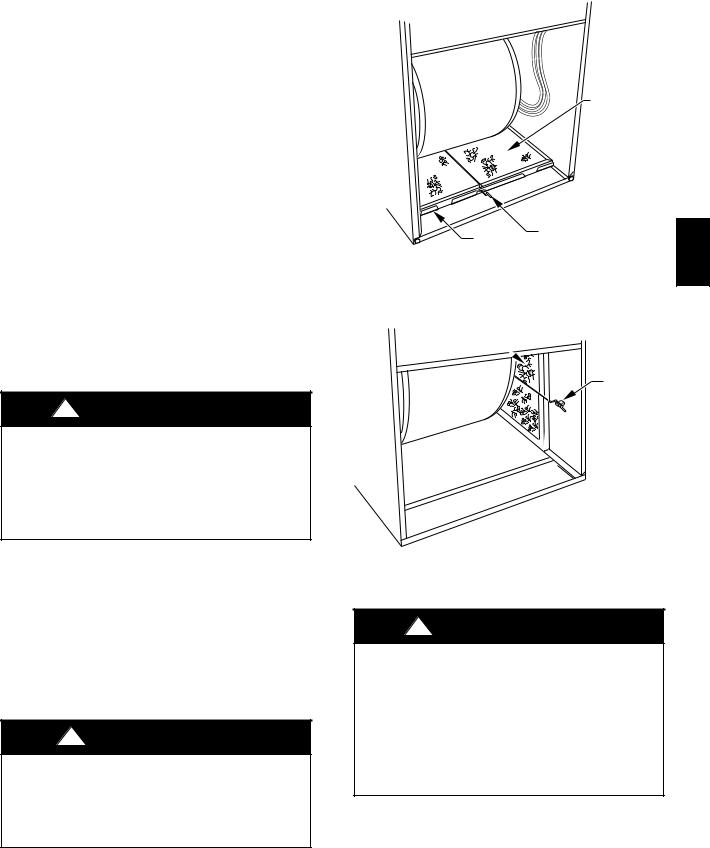
person’s hand during grounding will be satisfactorily discharged.
3.After touching the chassis, you may proceed to service the control or connecting wires as long as you do nothing that recharges your body with static electricity (for example; DO NOT move or shuffle your feet, DO NOT touch ungrounded objects, etc.).
4.If you touch ungrounded objects (recharge your body with static electricity), firmly touch furnace again before touching control or wires.
5.Use this procedure for installed and uninstalled (ungrounded) furnaces.
6.Before removing a new control from its container, discharge your body’s electrostatic charge to ground to protect the control from damage. If the control is to be installed in a furnace, follow items 1 through 5 before bringing the control or yourself into contact with the furnace. Put all used AND new controls into containers before touching ungrounded objects.
7.An ESD service kit (available from commercial sources) may also be used to prevent ESD damage.
CARE AND MAINTENANCE
For continuing high performance and to minimize possible furnace failure, it is essential that maintenance be performed annually. Consult your local dealer for maintenance and maintenance contract availability.
!WARNING
ELECTRICAL SHOCK HAZARD
Failure to follow this warning could result in personal injury or death.
Turn off the gas and electrical supplies to the unit before performing any maintenance or service. Follow the operating instructions on the label attached to the furnace.
The minimum maintenance that should be performed on this equipment is as follows:
1.Check and clean or replace air filter each month as needed.
2.Check blower motor and wheel for cleanliness annually.
3.Check electrical connections for tightness and controls for proper operation each heating season. Service as necessary.
4.Check for proper condensate drainage. Clean as necessary.
5.Check for blockages in combustion-air and vent pipes annually.
6.Check burners for cleanliness annually.
!CAUTION
CUT HAZARD
Failure to follow this caution may result in personal injury.
Be careful of sharp metal edges, etc. Use care and wear protective clothing, gloves, and safety glasses when removing parts.
Step 1 — Cleaning and/or Replacing Air Filter
The air filter arrangement may vary depending on the application or orientation. See Table 1 or 2 for filter size and type.
FILTER
FILTER |
FILTER |
58MCB |
A08586 |
||
SUPPORT |
RETAINER |
|
|
|
Fig. 3 - Bottom Filter Arrangement
FILTER 
FILTER
RETAINER
A08587
Fig. 4 - Filter Installed for Side Inlet
!WARNING
FIRE, CARBON MONOXIDE POISONING HAZARD
Failure to follow this warning could result in personal injury, death or property damage.
Never operate unit without a filter or with the blower access panel removed. Operating a unit without a filter or with the blower access door removed could cause damage to the furnace blower motor. Dust and lint on internal parts of furnace can cause a loss of efficiency.
NOTE: If the filter has an airflow direction arrow, the arrow must point toward the blower.
To clean or replace filters, proceed as follows:
If filter is installed in filter cabinet adjacent to furnace:
3
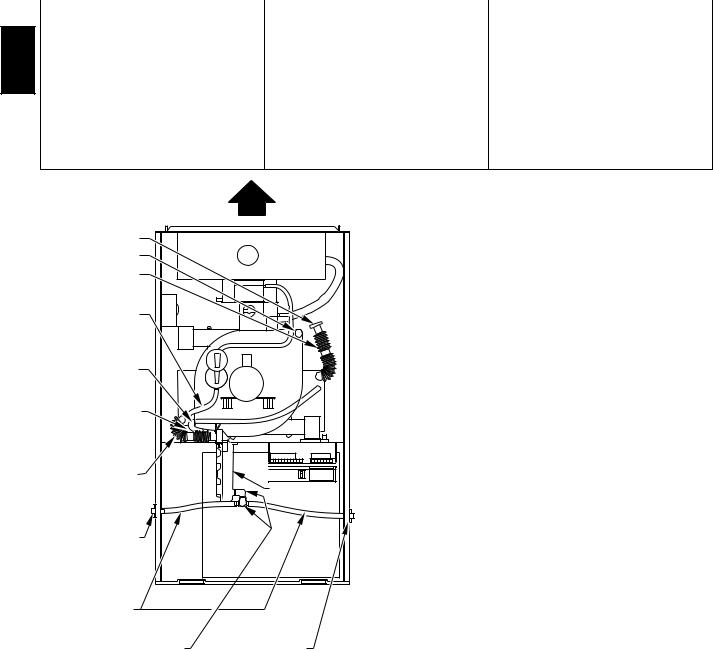
Table 1 – Furnace Air Filter Table
FURNACE CASING WIDTH |
FILTER QUANTITY AND SIZE * |
|
||
IN (MM) |
SIDE RETURN* |
BOTTOM RETURN* |
FILTER TYPE* |
|
IN (MM) |
IN (MM) |
|
||
|
|
|||
|
|
|
|
|
17---1/2 (445) |
(1) 16 x 25 x 3/4 |
(1) 16 x 25 x 3/4 |
3/4” (19 mm) thick washable |
|
(406 x 635 x 19) |
(406 x 635 x 19) |
|||
|
|
|||
|
|
|
|
|
21 (533 ) |
(1) 16 x 25 x 3/4 |
(1) 20 x 25 x 3/4 |
3/4” (19 mm) thick washable |
|
(406 x 635 x 19) |
(508 x 635 x 19) |
|||
|
|
|||
24---1/2 (610) |
(1) 16 x 25 x 3/4 |
(1) 24 x 25 x 3/4 |
3/4” (19 mm) thick washable |
|
(406 x 635 x 19) |
(610 x 635 x 19) |
|||
|
|
|||
|
|
|
|
|
58MCB
Table 2 – Air Filter Located in Filter Cabinet
FILTER CABINET HEIGHT --- IN (MM) |
FILTER SIZE --- IN (MM) |
FILTER TYPE |
|
|
(1) 16 x 25 x 3/4* |
|
|
16 (406) |
(406 x 635 x 19) or |
washable |
|
(1) 16 x 25 x 4---5/16 |
|||
|
|
||
|
(406 x 635 x 110) |
|
|
|
|
|
|
|
(1) 20 x 25 x 3/4* |
|
|
20 (508) |
(508 x 635 x 19) or |
washable |
|
(1) 20 x 25 x 4---5/16 |
|||
|
|
||
|
(508 x 635 x 110) |
|
|
|
|
|
|
|
(1) 24 x 25 x 3/4*or |
|
|
24 (610) |
(610 x 635 x 19) or |
washable |
|
(1) 24 x 25 x 4---5/16 |
|||
|
|
||
|
(610 x 635 x 110) |
|
*Filters with a side return-air may have a different filter size. Measure the filter to obtain the correct size.
2.Remove filter cabinet door.
3.Slide filter out of cabinet.
4.If equipped with permanent, washable filter, clean filter by
PLUG |
|
|
spraying cold tap water through filter in opposite direction |
|
|
of airflow. Rinse filter and let dry. Oiling or coating of the |
|
CAP |
|
|
|
|
|
filter is not recommended. |
|
|
|
|
|
COLLECTOR BOX |
|
5. |
If equipped with factory specified disposable media filter, |
DRAIN TUBE (BLUE |
|
|
replace only with a factory specified media filter of the same |
& WHITE STRIPED) |
|
|
|
|
|
size. |
|
COLLECTOR BOX |
|
|
|
|
6. |
Slide filter into cabinet. |
|
TUBE (PINK) |
|
||
|
|
|
|
|
|
7. |
Replace filter cabinet door. |
|
|
8. |
Turn on electrical supply to furnace. |
COLLECTOR BOX |
|
If filter is installed in furnace blower compartment: |
|
TUBE (GREEN) |
|
1. |
Turn off electrical supply to furnace. |
|
|
||
INDUCER HOUSING |
|
2. |
Remove main furnace door and blower access panel. |
|
3. |
Release filter retainer wire. (See Fig. 3 or 4.) |
|
(MOLDED) DRAIN |
|
||
TUBE (BEHIND |
|
NOTE: Filters shown in Fig. 3 and 4 can be in furnace blower |
|
COLLECTOR BOX |
|
||
DRAIN TUBE) |
|
compartment or in filter cabinet, but not in both. |
|
COLLECTOR BOX |
|
4. |
Slide filter out of furnace. |
DRAIN TUBE (BLUE) |
CONDENSATE |
5. |
If furnaces are equipped with permanent, washable filter(s), |
|
TRAP |
|
clean filter by spraying cold tap water through filter in op- |
|
|
|
posite direction of airflow. |
FIELD-INSTALLED |
|
6. |
Rinse filter and let dry. Oiling or coating filter is not recom- |
|
|
mended. |
|
FACTORY-SUPPLIED |
|
|
|
DRAIN TUBE |
|
7. |
Slide filter into furnace. |
COUPLING (LEFT |
|
||
|
8. |
Recapture filter retaining wire. |
|
DRAIN OPTION) |
|
||
FIELD-INSTALLED |
|
FACTORY-SUPPLIED |
|
DRAIN TUBE |
|
FIELD-INSTALLED |
FIELD-INSTALLED |
FACTORY-SUPPLIED |
FACTORY-SUPPLIED |
1⁄2-IN. CPVC STREET |
DRAIN TUBE |
ELBOWS (2) FOR |
COUPLING (RIGHT |
LEFT DRAIN OPTION |
DRAIN OPTION) |
A05110
Fig. 5 - Factory-Shipped Upflow Tube Configuration (Shown with Blower Access Panel Removed)
1. Turn off electrical supply to furnace.
9.Replace blower access panel and main furnace door.
10.Turn on electrical supply to furnace.
Step 2 — Blower Motor and Wheel Maintenance
To ensure long life, economy, and high efficiency, clean accumulated dirt and grease from blower wheel and motor annually.
The inducer and blower motors are pre-lubricated and require no additional lubrication. These motors can be identified by the absence of oil ports on each end of the motor.
The following items should be performed by a qualified service technician.
Clean blower motor and wheel as follows:
4
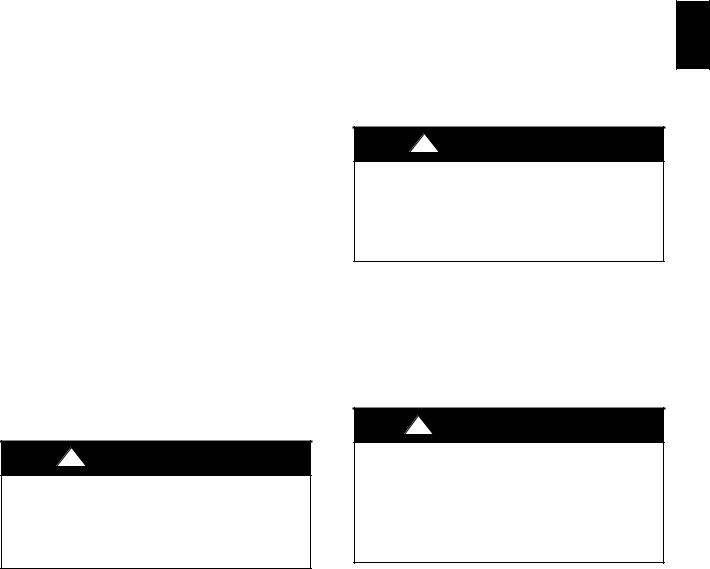
1.Turn off electrical supply to furnace.
2.Remove main furnace door and blower access panel.
3.Disconnect wires
All factory wires can be left connected, but field thermostat connections may need to be disconnected depending on their length and routing.
4.Remove control box mounting screws, and position control box, transformer, and door switch assembly to right side of furnace casing.
5.If condensate trap is located in leftor right-hand side of furnace casing, proceed to item 6. Otherwise remove trap and tubing as described below (See Fig. 5.):
a.Disconnect field drain connection from condensate trap.
b.Disconnect drain and relief port tubes from condensate trap.
c.Remove condensate trap from blower shelf.
6.Remove screws securing blower assembly to blower shelf and slide blower assembly out of furnace. Detach ground wire and disconnect blower motor harness plugs from blower motor.
NOTE: Blower wheel is fragile. Use care.
7.Clean blower wheel and motor by using a vacuum with soft brush attachment. Be careful not to disturb balance weights (clips) on blower wheel vanes. Do not bend wheel or blades as balance will be affected.
8.If greasy residue is present on blower wheel, remove wheel from the blower housing and wash it with an appropriate degreaser. To remove wheel:
a.Mark blower wheel location on shaft before disassembly to ensure proper reassembly.
b.Loosen setscrew holding blower wheel on motor shaft.
NOTE: Mark blower mounting arms and blower housing so each arm is positioned at the same hole location during reassembly.
c.Mark blower wheel orientation and cutoff plate location to ensure proper reassembly.
d.Remove screws securing cutoff plate and remove cutoff plate from housing.
e.Remove bolts holding motor mounts to blower housing and slide motor and mounts out of housing. Disconnect capacitor and ground wire attached to blower housing before removing motor. Motor mounts need not be removed from motor.
f.Remove blower wheel from housing.
!CAUTION
UNIT DAMAGE HAZARD
Failure to follow this caution may result in noise or furnace component failure.
The blower wheel should not be dropped or bent as balance will be affected.
g.Clean wheel per instructions on degreaser cleaner. Do not get degreaser in motor.
9.Reassemble motor and blower wheel by reversing items 8b through 8f. Ensure wheel is positioned for proper rotation. Be sure to reattach ground wire. Tighten setscrew to 140 to 160 in-lb torque.
NOTE: Be sure to attach ground wire to blower housing.
10.Reinstall blower assembly in furnace.
11.Reinstall control box, transformer, and door switch assembly on blower shelf.
12.Reinstall condensate trap and tubing if previously removed.
a.Reinstall condensate trap in hole in blower shelf.
b.Connect condensate trap drain tubes. See Fig. 5 or tubing diagram on main furnace door for proper tube location.
NOTE: Ensure tubes are not kinked or pinched, as this will affect operation.
(1.) Connect one tube (blue or blue and white striped) from collector box.
(2.) Connect one tube (violet or unmarked) from inducer housing.
(3.) Connect one tube (relief port, green or pink) from collector box.
c. Connect field drain to condensate trap.
NOTE: Ensure tubes are not kinked or pinched, as this will affect operation.
13. |
Reinstall control box, transformer, and door switch as- |
58MCB |
|
sembly on blower shelf. |
|
14. |
Reconnect wires. Refer to furnace wiring diagram and con- |
|
|
nect thermostat leads if previously disconnected. (See Fig. |
|
|
|
|
|
21.) |
|
NOTE: Refer to Table 3 for motor speed lead reconnection if leads were not identified before disconnection.
!CAUTION
UNIT DAMAGE HAZARD
Failure to adjust the heating speed may shorten heat exchanger life.
Heating speed selection MUST be adjusted to provide proper temperature rise as specified on the rating plate.
Table 3 – Speed Selection
COLOR |
SPEED |
FACTORY |
|
ATTACHED TO |
|||
|
|
||
|
|
|
|
Black |
High |
Cool |
|
Yellow (When Present) |
Medium High |
Spare |
|
Blue |
Medium Low |
Heat |
|
Red |
Low |
Fan |
|
White |
Common |
Com |
!WARNING
ELECTRICAL SHOCK HAZARD
Failure to follow this warning could result in personal injury or death.
Blower access panel door switch opens 115-v power to furnace control. No component operation can occur. Caution must be taken when manually closing this switch for service purposes.
15.Turn on electrical supply. Manually close blower access panel door switch. Use a piece of tape to hold switch closed. Check for proper rotation and speed changes between heating and cooling by jumpering R to G and R to Y/Y2 on furnace control thermostat terminals. (See Fig. 15.)
16.If furnace is operating properly, release blower access panel door switch, replace blower access panel, and replace main furnace door.
5
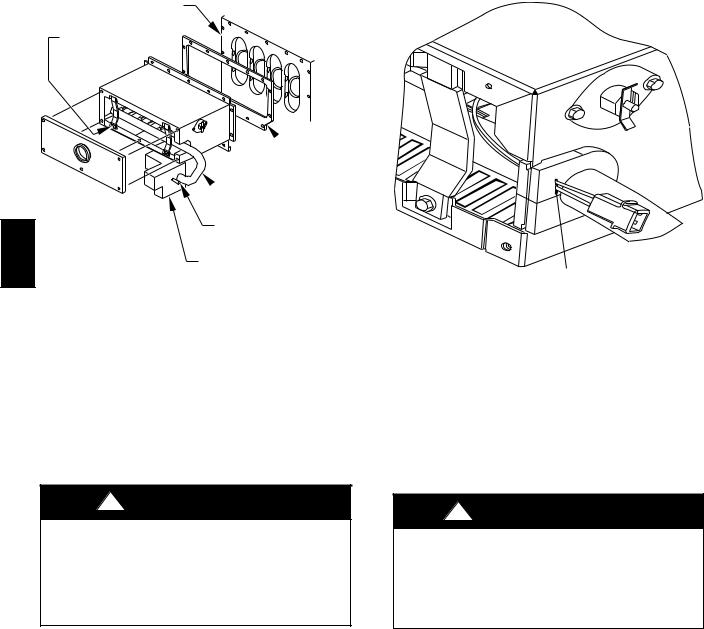
58MCB
CELL
PANEL
MANIFOLD
MOUNTING
SCREWS
 GASKET
GASKET
 MANIFOLD
MANIFOLD
GAS VALVE
REGULATOR
FITTING
GAS
CONTROL
VALVE
A02312
Fig. 6 - Burner Box Assembly
Step 3 — Cleaning Burners
The following items should be performed by a qualified service technician. If the burners develop an accumulation of light dirt or dust, they may be cleaned by using the following procedure:
1.Turn off gas and electrical supplies to furnace.
2.Remove main furnace door.
3.Remove burner box cover.
4.Using backup wrench, disconnect gas supply pipe from furnace gas control valve.
!CAUTION
UNIT DAMAGE HAZARD
Failure to follow this caution may result in furnace component damage.
Label all wires prior to disconnection when servicing controls. Wiring errors can cause improper and dangerous operation.
5.Remove wires from gas valve. Note location for reassembly.
6.Remove burner box pressure tube from gas valve regulator fitting.
7.Unplug igniter from harness.
8.Remove igniter leads from slot in manifold grommet.
9.Remove screws that secure manifold to burner box. (See Fig. 6.)
NOTE: Do not remove burner box from cell panel.
10.Remove manifold, orifices, and gas valve as one assembly.
11.Remove screws attaching burner assembly in burner box.
NOTE: Use care when removing and reinstalling burners not to strike the hot surface igniter.
IGNITER WIRES MUST
BE PLACED IN THIS SLOT
A05074
Fig. 7 - Igniter Wire Placement
12. Remove burner assembly from burner box.
NOTE: All burners are attached to burner bracket and can be removed as one assembly.
13.Clean burners with soft brush and vacuum.
14.Reinstall manifold, orifice, and gas valve assembly in burner box. Ensure manifold seal grommet is installed properly and burners fit over orifices.
15.Reinsert the igniter wires in the slot in the manifold grommet, dressing the wires to ensure there is no tension on the igniter itself. (See Fig. 7.)
!WARNING
ELECTRICAL SHOCK HAZARD
Failure to follow this warning could result in personal injury or death.
Igniter wires must be securely placed in slot in manifold grommet or else they could become pinched or severed and electrically shorted.
16.Reconnect wires to gas valve and igniter. Refer to furnace wiring diagram for proper wire location.
17.Reinstall burner box pressure tube to gas valve regulator fitting.
18.Reinstall gas supply pipe to furnace gas control valve using backup wrench on gas valve to prevent rotation and improper orientation.
NOTE: Use propane gas resistant pipe dope to prevent gas leaks. DO NOT use Teflon tape.
6
